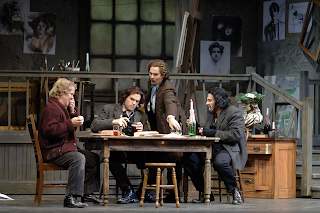 By Paul Horsley
By Paul Horsley Konstantin Lifschitz, the Ukrainian-born pianist, is one of those restless musical spirits who sails uncharted waters seeking ever-elusive truths behind musical masterpieces. There was a mystical, almost séance-like atmosphere to his Friends of Chamber Music recital on Friday, the 31-year-old pianist’s only appearance in the United States this season.
Expectations were high for this program of Beethoven, Bach and Frescobaldi: As a teenager, Lifschitz caused a minor sensation with a recording of Bach’s Goldberg Variations, which was nominated for a Grammy, and a more recent recording of Bach’s Musical Offering is similarly spectacular. So it was with some surprise that I left the Folly Theater after this 2 ½-hour recital with mixed emotions — awe and fascination mingling with bafflement and frustration.
Lifschitz uses the music of the masters for his own deeply personal explorations. But there is sometimes a fine line between freshness and self-indulgence, between revealing new truths about Beethoven and stretching a phrase so wantonly that it ceases to be musical. At his best, Lifschitz can shed fresh light on music that you thought you were familiar with, making it sound strangely foreign. That’s not always a comfortable feeling — it’s like getting outside of your musical “comfort zone” — but in a world of interpretive sameness it’s something we could all use more of. I liked his puckish approach to Beethoven’s E-flat major Sonata (Op. 31, No. 3), which was architectural in design with nutty gargoyles accenting the structure. Lifschitz is attuned to Beethoven’s obsessive nature, but he sometimes exaggerates quirks and repetitions in a way that makes you despair for one single un-gussied phrase. The sweet little descending motif that permeates the first movement (DEE—da-dum), for instance, was less like a melody than a “special effect.”
He took these eccentricities to maddening extremes in the loopy first sonata of Beethoven’s Op. 31 (in G major), putting us into an impressionistic trance for nearly 40 minutes. You had to admire his relentless poise through this ethereal romp, even in the slow movement where the energy slowly drained into over-pedaled oblivion. The finale was barely this side of coherent, more like Boulez than Beethoven. Fortunately the D-minor Sonata (The Tempest) was saner and more grounded, even though one could have taken a coffee break during the fermata pauses in the opening theme.
The recital opened with three toccatas by Frescobaldi, a rarity on a piano recital and quite a novelty except that they were so inward that they bordered on preciousness. It closed with the two Ricercars from the Musical Offering, played with far more pedal and tempo-stretching than on the pianist’s own recorded versions, again suggesting that Lifschitz views a recital as a special event unrelated to any recording he might have made (and there’s nothing wrong with that). Notable among the encores were Bartok’s Rumanian Folk Dances and the Gigue from Bach’s G-major French Suite.
To reach Paul Horsley, send email to phorsley@sbcglobal.net

 By Paul Horsley
By Paul Horsley













